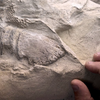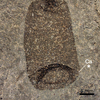Snakestones, Shaligrams, Ammonites, Oh My! All About Ammonites

An ammonite fossil with a carved snake head!
Post Author- Ellis Nolan
Ammonites, the aquatic ancestor of cephalopods such as the octopus and nautilus, have captured our imaginations for centuries. Their spiraling fossilized shells have been known by many names throughout history. Here is our roundup of the most fascinating ammonite folklore!
Ammonites found in England in the seventh century and beyond were often known as Snakestones, since the coiled fossil shells look similar to curled up snakes. There are numerous folk myths related to snakestones, one of which ascribes their origin to Saint Hilda. The seventh-century saint was tasked with removing all snakes from an area where an abbey was to be constructed in Whitby, England; to do this, she turned them all to stone using a magical spell. The coiled snakestones appear commonly in the iconography of Whitby and Saint Hilda owing to this myth.
But, of course, snakestones (ammonites) don’t have a stone head intact (although many artisans carved beautiful snake heads into fossilized ammonites)! Another snakestone myth says that Saint Cuthbert (who was said to wear a rosary of crinoid beads) cast a spell beheading all of the snakes in Whitby.
Around the world, Ammonites are known by many other names, and are often thought to have medicinal or healing properties. The name “ammonite” actually derives from the ancient Greeks, who knew the fossils as “horns of Ammon,” after the God Ammon, who was often depicted with the horns of a ram. Ancient Romans also believed pyritized ammonites, fossils infused with pyrite, or fool’s gold, could be used to tell the future.
In Hinduism, shaligrams, which are fossils often containing ammonites found on the banks of the Gandaki river in Nepal, are considered symbolic representations of Vishnu, one of the principal deities of the religion. This is because the ribs of the ammonite spiral resemble Vishnu’s chakra, a disc-shaped weapon often depicted in one of the deity’s hands.
Ammonites are also experiencing a resurgence in popularity in today’s culture, with many boutique and high end jewelers featuring them prominently in their works. One maker creates earrings with ammonite fossils set in gold with pearl accents, that retail for almost 3,000 USD. Many fashionistas enjoy that the ammonites stand out in a world of diamonds and sapphires, as well as their imbuement with the primordial history of life on Earth
Whether they’re known as snakestones, shaligrams or ammonites, it seems these spiral stones will always represent the magical and spiritual realms. Who knows what further research into these fascinating creatures will find!
Interested in learning more about Ammonites or purchasing your own? Check out our Ammonite collection here!
Featured Product
Joe Frazier Boxing Glove
Cool Things!

Is “Paul is Dead” Dead?: Unpacking One Of Pop Culture’s Most Enduring Conspiracy Theories

Scientists Discover Hooves and Skin in Preserved Dinosaur "Mummies!"
A dinosaur discovery just in time for Halloween! In a new analysis of a group of fossils from Wyoming, Scientists have determined this group of fossils are dinosaur “mummies,” with preserved skin and even hooves.

Scientists Record a Bat Catching Birds Mid-Flight!
Bats, birds, screeches, oh my! In a reverse-Hitchcock twist, a new study reveals that a species of European bat catches and eats birds mid-flight.
Specimen Deep Dives

The House that Ruth Built: The Story of the Old Yankee Stadium

The Queen of the Skies: the Story of the Boeing 747

Old Ironsides: The USS Constitution and the Start of the U.S. Navy
Long Form Articles

The Artist Behind the Macintosh: Susan Kare and Apple Computers
While the two Steves, Jobs and Wozniak, are the most well known faces behind Apple computers, equally important to the products and culture of the company were those who crafted the experience of using their computers through design. The most notable of these visual architects was Susan Kare, a designer responsible for “humanizing” Macintosh computers.

Can I Lick It? Yes You Can!
Have you ever been unable to tell if a fossil was really a fossil, but you were too embarrassed to admit it? Have you ever wanted to lick a fossil just because, but you didn’t want to risk judgment from your peers? Well, good news! You can kill two birds with one stone! Licking a fossil can actually help you determine if it’s the real deal or just another rock.

Is It Legal To Own a Meteorite: How to Start Your Outer Space Collection!
Meteorites are some of the rarest geological specimens to be found on Earth. Of course, since these stones are not of our world, purchasing them can sometimes be a confusing process. Is it legal to own a meteorite? In short, yes! Read on for help starting your cosmic collection!


















